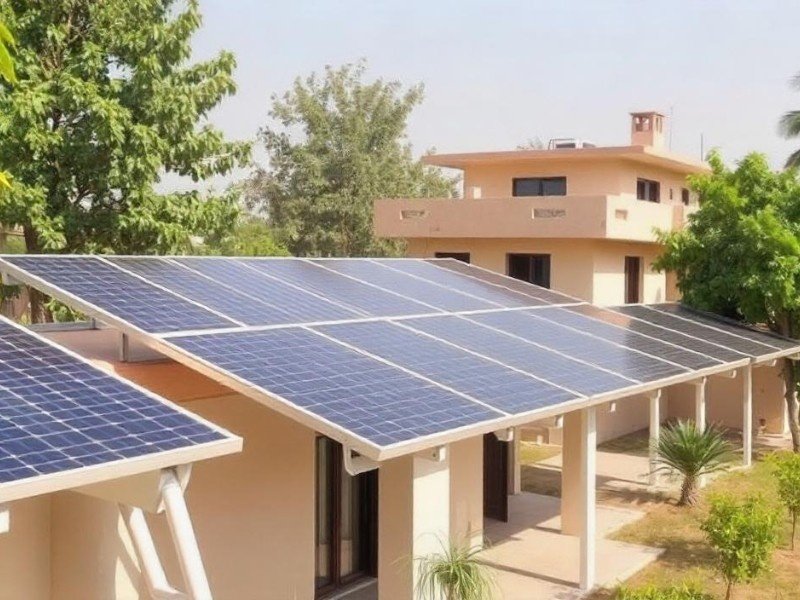India receives plenty of sunlight throughout the year, which makes solar panels a great choice for utilizing clean, eco-friendly, and cost-effective energy. To facilitate the transition towards solar, our government provides several subsidies in the market for solar panels to reduce their costs. Programs such as PM Surya Ghar Muft Bijli Yojana for homes and PM-KUSUM for farmers make clean energy more accessible.
In this guide, you’ll learn everything about solar panel subsidies in India, including eligibility, benefits for homes, businesses, and farms, and the step-by-step process to apply and claim your subsidy for maximum savings.
What is the Solar Panel Subsidy?
A solar panel subsidy is a government-provided financial incentive that reduces the upfront cost of installing solar panels. These incentives help homeowners, businesses, and farmers save on installation expenses while encouraging the adoption of renewable energy.
Government subsidies can take the form of tax credits, rebates, or grants and lower the initial cost of solar panel installation. By providing financial relief to homeowners, these subsidies help lower electricity bills while also enhancing environmental sustainability, supporting the reduction in dependence on fossil fuels, and growing India’s green economy.
In short, a subsidy for solar panels is a helpful financial incentive from the government, which makes it easier to transition to renewable energy sources.
Solar Panel Subsidies for Homes, Businesses, and Farms
Government subsidies on solar panels are designed to be appropriate for different users, each with developed benefits that are varied for residential, commercial, and agricultural users.
1. Residential Use
Homeowners can access the many schemes available, including PM Surya Ghar Muft Bijli Yojana, each of which provides monetary assistance to homeowners who install rooftop solar systems. Subsidies help in reducing your monthly electricity bills. Additionally, it may also help you install a hybrid or battery backup system that can assist a family that would like to save money in the long run and become energy independent.
2. Commercial Use
Commercial enterprises like offices, malls, and shops can benefit from state-based incentives. Users can also benefit from subsidies that encourage net metering, which means you can sell any extra solar energy you generate back to the grid, which reduces business operations costs.
3. Agricultural Use
Farmers also have specific schemes like PM-KUSUM for subsidising solar pumps and solar-powered irrigation systems. This program assists farmers with weaning themselves from grid electricity and diesel pumps, which allows them to save costs while promoting alternative electricity.
By developing subsidies that apply to the type of user, the government has made solar energy accessible, making it less expensive and practical whether you are a home, business, or farm.
Choosing the Right Solar Subsidy
Before investing in a solar setup, it’s essential to evaluate a few critical factors that determine how well your system will meet your energy needs and deliver value over time.
- 1
Assessing Energy Needs: Start by understanding how much electricity you use daily and during peak hours. Review your power bills and think about any future increase in usage. This helps determine the right system size and capacity to efficiently meet your energy requirements.
- 2
Site Suitability and Solar Potential: The location of installation directly affects performance. Ensure your site gets plenty of sunlight with minimal shading and enough open space for panels. Orientation and tilt angle are also key factors in maximizing energy output.
- 3
System Type: Choose the system type based on your energy goals.
- On-grid systems connect to the utility grid and allow net metering.
- Off-grid systems work independently with batteries for energy storage.
- Hybrid systems combine both, ensuring energy security and flexibility.
- 4
Quality and Efficiency of Solar Panels: Invest in high-quality panels with strong warranties and proven efficiency. While they may cost more initially, they deliver better performance and long-term savings due to higher energy generation and durability.
- 5
Inverter Selection: Inverters convert solar DC power into usable AC power. Choose one that matches your system’s capacity and quality needs. Common types include string inverters, microinverters, and power optimizers, each offering different benefits in terms of performance and maintenance.
- 6Financial Considerations and ROI: Evaluate costs, available subsidies, and the expected payback period. Government incentives and net metering can lower installation expenses. Estimating your return on investment helps you understand long-term savings and overall value.
- 7
Choosing a Reputable Solar Installer: Partner with a certified and experienced installer for reliable setup and after-sales support. Companies like VC Green Energy Private Limited are known for their quality workmanship, transparent service, and customer satisfaction.
How Much Subsidy Can You Get?
The government offers attractive subsidies to make solar energy adoption more affordable. The exact amount depends on the size of your rooftop solar system. Under the PM-SURYA GHAR: MUFT BIJLI YOJANA scheme, an Indian household can receive a subsidy of ₹30,000 for a 1 kW solar system.
Here’s the current structure under the PM Surya Ghar Muft Bijli Yojana:
This means households installing larger systems (like 5 kW or 10 kW) will still receive a maximum subsidy of ₹78,000, making it important to plan system size based on actual usage and savings.
Other Benefits Alongside Subsidy
Eligibility and Key Requirements for Solar Subsidy in India
Before applying for a solar panel subsidy in India, it’s important to understand who qualifies and what conditions must be met. The government has set clear guidelines so that subsidies reach genuine beneficiaries and promote the use of reliable, India-made solar systems.
To qualify, you must:


Step-by-Step Guide to Getting Solar Panel Subsidy
The Government of India, through the Ministry of New and Renewable Energy (MNRE), provides various subsidy schemes to promote solar energy adoption. Homeowners, businesses, and farmers can avail themselves of financial support by following a simple application process. Before applying, gather the necessary documents:
- 1
Proof of identity (Aadhaar, PAN, etc.)
- 2Address proof
- 3
Proof of property ownership
- 4Recent electricity bill (applicant name must match)
Steps to Apply:
Applying for a solar panel subsidy in India is a straightforward process, and most of it can be done online. Here’s a step-by-step breakdown:
- 1
Visit the Official Portal: Go to the Government subsidy portal, like the PM Surya Ghar Muft Bijli Yojana website, and log in. Click on “Apply for Rooftop Solar”.
- 2
Fill in Your Details: Select your state, district, and electricity distribution company (DISCOM). Enter your customer account number, mobile number, and email ID to complete the registration form.
- 3
Feasibility Check by DISCOM: Your electricity company will review the application and check whether your rooftop is suitable for installing solar panels. You’ll receive approval if your roof meets the required conditions.
- 4Choose an Approved Vendor: Once approved, select an MNRE-registered solar installation company from the portal to carry out the installation.
- 5
Installation and Net Metering: After the panels are installed, request a net meter connection. DISCOM will inspect the setup and, upon successful verification, issue a commissioning certificate.
- 6Submit Bank Details: Log back into the portal and provide your bank account information along with a cancelled cheque. The subsidy amount will then be credited directly to your account.
Maintaining Your Solar Panels
Proper care after installation makes sure your solar system works efficiently for years. Regular maintenance, monitoring, and safety checks can help you maximize savings and protect your investment.
Benefits and Challenges of Solar Panel Subsidies
Government solar panel subsidies offer significant financial and environmental benefits, but applicants may face certain hurdles during the process. Understanding both the advantages and challenges helps homeowners and businesses.
1. Benefits
2. Challenges
By understanding these benefits and challenges, applicants can better navigate the process and maximize the advantages of solar subsidies.
FREE SOLAR EXPERT CONSULTATION
Conclusion
Transitioning to solar won’t just lower your electrical expenses. You’ll also help the environment and promote energy independence. Partnering with knowledgeable and MNRE-approved suppliers can streamline the process with mindful installation practices, subsidy approval, and give your solar system long-lasting performance. Companies like Alpex Solar specialize in helping homeowners, businesses, and farmers in every aspect of the solar market, while at the same time creating maximum savings and efficiency for you.




